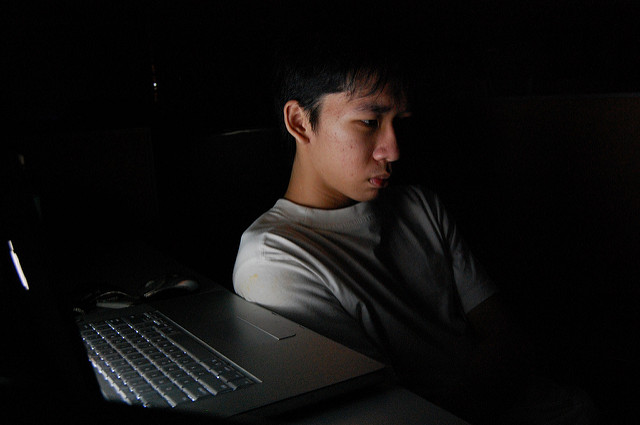In one of my previous blog posts, I discussed the issue of children and adolescents using online social media and the associated risks of cyberbullying. To further explore these issues, I met with Louise Arseneault, Professor in Developmental Psychology, to discuss the impact that bullying can have on young people and whether we should be more worried about bullying that occurs online.

Alicia: Your research highlights that childhood bullying is something that many children fall victim to and is increasingly recognised as a public health concern. What sort of impact can childhood bullying like this have?
Louise Arseneault: Our studies have shown a link between childhood bullying and risk of mental health disorders in children, adolescents and adults. In one study, we identified children who experienced bullying between the ages of 5 and 7 years, and collected reports from mothers and teachers about children’s’ emotional and behavioural problems and happiness at school. We found that, at age 7, children who had been victims of bullying during those two years had more emotional problems, such as anxiety and depression, and were less happy at school. Girls who had been victims of bullying during this time also showed more conduct problems. Moreover, the association between experiencing bulling and higher levels of emotional and behavioural problems at age 7 remained robust even after controlling for pre-existing adjustment problems at age 5. This highlights that being the victim of bullying during the first years of school can have a detrimental effect on children’s’ adjustment. This research also suggested that there are some factors that can make a child more likely to be bullied. These findings were highly controversial, as it was previously believed that those who fall victim to bullying were often just in the wrong place at the wrong time. Due to this, many interventions to help children who had been bullied stressed that the bullying was not the child’s fault. However, we found that children who were bullied between the ages of 5 and 7 had also shown more pre-existing emotional problems at age 5 compared with controls, and were less happy during their first year at school. This suggests that these factors could increase a child’s chances of being bullied. Nonetheless, being a victim of bullying in the first two years of school uniquely contributed to an increase in adjustment problems for young children.
A: How long lasting is this impact?
LA: The emotional health problems that victims of bullying often experience tend to last. Evidence suggests that individuals who were bullied in childhood have adjustment problems in late adolescence and in adulthood, and that being bullied even increases the risk of depression between the ages of 31 and 51 years.
A: Do the impacts of bullying differ for victimisation that occurs online?
LA: Cyber harassment has also been associated with a negative impact on mental health. Our research found that, in adolescents aged 12-18, online and internet harassment were significantly associated with poor mental health. However, when other forms of victimisation are controlled for, such as childhood maltreatment, the effect disappears. This suggests that the association is not as robust as originally believed.
A: Do you think bullying has become more widespread since more children have become increasingly exposed to online social media?
LA: Given the large amounts of negative press that cyberbullying has received in the media, it is easy to see why so many people assume that online victimisation is extremely prevalent. However, research suggests that only approximately 20.6% of adolescents have been victimised online, which is similar to the rates of other forms of face-to-face bullying. Moreover, when estimating the prevalence of severe and/or frequent online harassment, only 6.5% of adolescents reported being victimised.

“Online victimisation can be harder to escape from” Photocredit: https://www.flickr.com/photos/wentongg/
A: Why do so many of us assume that online victimisation is so much more prevalent? Does it differ from other forms of bullying?
LA: Online victimisation can be distinguished from other traditional forms of bullying by three main features, the presence of which are often thought to make online bullying so much worse. Firstly, online victimisation is much harder to escape from. If I child is being bullied at school, they are away from the bullying when at home. However, online harassment can continue no matter where the victim is. Another factor is the breadth of the potential audience. For example, if a picture or video is being used to intentionally embarrass a victim, the online audience that it may reach has the potential to be far larger than the small groups that usually witness traditional bullying. Finally, online victimisation is not a face-to-face experience, providing the bully with some degree of “invisibility” or anonymity. This may make the bully less aware of the consequences of their actions, and also presents fewer opportunities for remorse or bystander intervention.
A: Do you think parents are right to be concerned about their children using social media?
LA: Parents should definitely be aware of the potential risks of their children being online, it would be naïve to think that there are no potential dangers. Like anything adolescents often want to engage in, such as watching TV or starting to drink alcohol, being on the internet needs to be monitored by parents. If parents have a better knowledge of the risks, they can teach their children to be more tech savvy, which they will only gain by experiencing the online world themselves. Education is needed to help children avoid the traps and pitfalls of the internet and for them to see the true danger of being over trusting online. Even though it is advantageous to be wary, the benefits of new technology need to be acknowledged. For children and adolescents there are clear benefits, such as being able to communicate with friends. Being aware of risks can help young people to use this technology more safely.
A: And, in conclusion…?
LA: Research suggests that online victimisation is not the epitome of abuse that some believe it is. A more balanced view of children’s’ online presence is needed to ensure that parents have the knowledge to help protect their children online. The most important thing is that children know to be wary of some things on the internet, so they know how to behave and what to avoid.
You can follow Louise on Twitter @L_Arseneault and find out more about her work here


[…] Alicia’s blog post together with more from the EDIT […]